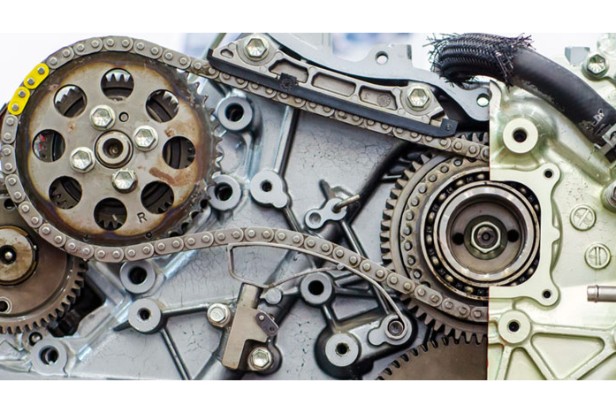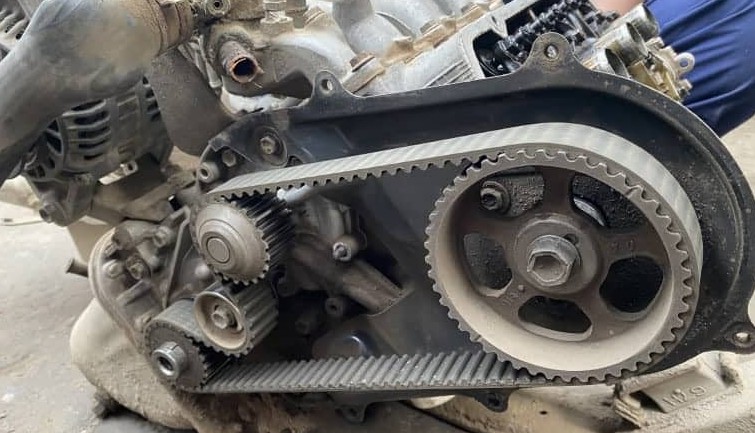
How to Tell If Your Vehicle Has A Bad Timing Belt – 4 Symptoms
The timing belt is situated in front of the engine in your car. It is made of a sturdy rubber material with nylon-reinforced cords. In this manner, the timing belt’s life can be prolonged.
The timing belt experiences a lot of stress as it rotates inside the motor, which is why it tends to deteriorate quickly. As a result, the timing belt will need to be changed on a schedule established by the car’s manufacturer.
How A Timing Belt Works
The crankshaft, which controls the engine’s pistons, is connected to the camshaft by the timing belt. The camshaft is in charge of opening and shutting the valves.
Overall, by regulating the timing of the crankshaft and camshaft, the timing belt ensures that the engine operates as efficiently as possible.
Read More: What is Time Belt
Symptoms Of A Bad Timing Belt
These signs and symptoms could show up if your timing belt is damaged or worn out. When you notice one or more of these signs, have the timing belt inspected and, if necessary, replaced by a qualified auto technician or mechanic.
Rough Idling
A timing belt has tiny teeth or ridges on the edges to aid in movement, as you can see when you look at one. This will make it easier for it to transition between gears and rotate through the system’s various parts. These ridges flatten out as the belt ages, the belt becomes looser, and the gear meshes aren’t as tight. The engine may idle unevenly as a result of this procedure. The longer this goes on, the more likely it is that the engine will eventually stall.
Misfire Of The Engine
Because the timing belt is worn out, the engine’s fire rate may be compromised. One of the cylinders would open and close prematurely if the timing belt were to separate from the gears and land on the camshaft.
If that occurs, an engine misfire may occur, necessitating an urgent belt replacement. The engine could sustain long-term damage if the belt isn’t changed right away.
Smoke From The Engine
It might be challenging to distinguish between the massive amounts of smoke coming from your tailpipe and the unharmful steam or water vapor if it is winter and cold outside. On the other hand, if there is excessive smoke that is out of the ordinary even for the winter, a timing belt issue may be to blame.
Two holes located at the top of each cylinder are used to draw in air and release exhaust. These holes open and close in time with how the cylinders move and how the camshaft rotates.
If your timing belt is worn out, your engine will become out of sync, allowing exhaust to escape and air to enter at the wrong times. Your exhaust system will be filled with smoke as a result.
A Drop In Oil Pressure
Your car’s vital component is oil. Your engine won’t run if it doesn’t have the right amount of oil. Furthermore, maintaining that can be very expensive. Often, total replacement is the only option.
Driving while paying attention to all gauges can help you spot potential issues. Oil pressure can decrease due to a timing belt failure. If you see this, stop right away and turn off the engine. An untimely camshaft timing can result in pieces breaking off and falling into the oil pan. This can be caused by a failing timing belt. The worst-case scenario is this. Because most people pay attention to other warning signs before this one, it doesn’t happen frequently.
The timing belt being severed or broken entirely is the worst symptom you can encounter. If this is the case, the crankshaft will eventually start rotating independently and out of step with the camshaft’s movement.
The valves will then open, bringing the piston into contact with them. The piston or valves may be harmed as a result of this.
When you notice this symptom, turn off the engine right away to stop further damage to it. If you do this, you might be able to keep your engine from suffering severe damage.
Average Cost To Replace A Timing Belt
A timing belt’s replacement cost is based on the number of labor hours required to complete the replacement task. After all, some car parts, like the timing belt, are much more difficult to access than others.
Because they are simpler to disassemble, labor costs for small-engine economy cars should be lower. However, if you drive a truck or an SUV, you will pay more because of the larger engines.
The average cost to replace a timing belt will be anywhere from $300 to $500 in total (more for larger cars, trucks, and The timing belt itself typically costs less than $50, but labor costs make up the majority of the cost of a timing belt job.
Anywhere from $250 to $450 or more will be required for the labor. Taxes and other charges will probably be added to these prices as well.
NOTE: Since it’s in the same place and needs to be replaced, it’s frequently advised to do so simultaneously. A new water pump might cost a little bit more, but compared to doing it later, you’ll save a lot of money on labor costs.

When Should A Timing Belt Be Replaced?
One of those items that must be replaced in accordance with the auto manufacturer’s schedule is a timing belt. Most often this will be between every 75,000 and 100,000 miles. The precise schedule for your vehicle can be found in the owner’s manual.
It is not a task that you can put off indefinitely, such as replacing your timing belt. The belt will eventually fail, potentially causing thousands of dollars in engine damage. The risk is simply not worth it.
Read More:
- Drive Belt vs Timing Belt: Differences & How to Choose
- Timing Belt vs Serpentine Belt – Are They The Same
Timing Belt Replacement Process
Timing belt replacement is not a simple DIY project and should be left to a professional unless you have extensive auto repair experience.
By removing various accessories, the mechanic must gain access to the engine’s timing cover. Once the cover has been removed, the mechanic will examine the timing belt and its pulleys to determine what needs to be replaced.
He’ll now start taking out the timing belt and installing a new one. If they believe it is necessary, they will probably replace the water pump, pulleys, and tensioners.
He will reinstall the timing cover and any other removed parts after all the new components have been installed. After everything has been put back together, the system can be tested by starting the engine.
Is the engine operating as it should? The engine’s timing is it correct? You’re in good shape if the responses to these two questions are affirmative. After paying the mechanic, everything is finished.
How To Check Timing Belt
The most important part that needs to be replaced on your car is the timing belt. Timing is everything, as we all know! We’ll examine how to determine when to replace the timing belt. A good rule of thumb for a term is to check it every 10,000 miles and replace it strictly as the manufacturers advise in your service booklet, typically between 60,000 and 90,000 miles. You can check the timing belt in two different ways. They are as follows:
Visual inspection: There are built-in inspection ports in some timing belt-using vehicles. In order to perform a visual inspection, there is typically a small cover on the timing cover that is simple to remove without removing the entire timing cover. Two 100mm bolts are typically used to tighten these covers.
Remove the cover and the two bolts to inspect your timing belt. Examine the timing belt closely, looking for any cracks and missing teeth. A single missing tooth can seriously harm an engine, which could cost you up to $700 to repair. Checking your timing belt every 10,000 miles is therefore a good idea. Additionally, you will rotate the timing belt a little to check for excessive looseness. Because it will make a bad timing belt noise if it is loose.
Using a Timing Gun/light: If you remove your engine to check your timing belt and discover that it is still in good condition, the time you spent doing so will have been completely wasted. Therefore, using a timing gun to check your timing belt is the best way to prevent this. Additionally, you can check your timing chain using the gun.
You must connect the terminals of your timing gun to the battery terminals in order to use it to check the timing belt. Positive to positive and negative to negative connections should be made. Then, start your car by taking the inductor sensor and attaching it to the first plug wire.
Now, if you’re a mechanic or a do-it-yourselfer, use white paint to paint the timing mark on the pulley so it will be clear when you flash the light on it. While the engine is running and being revved, the pulley’s light should flash. Your timing chain or belt is still in good shape if the mark remains in the same location. The timing belt is damaged if it jumps while you are flashing the light, though.
What Should You Do If Your Car Has Timing Belt Issues?
Timing belts typically need to be changed every 60-80,000 miles. For service intervals, consult the car’s owner’s manual.
At 60,000 miles, you should have your timing belt inspected if there is no record of it having been replaced. Failure to maintain or replace your timing belt can lead to catastrophic engine failure, which could cost you thousands of dollars.
It’s crucial to keep in mind that preventative maintenance is much less expensive than required maintenance. Get your timing belt checked by an ASE-certified mechanic if you think it may be broken or failing; they will be able to thoroughly inspect the belt and identify any problems.
Conclusion
The engine in your car is a very complex component that also includes a number of auxiliary parts, like the timing belt, chain drive, or working fluid. The timing belt of an engine has been discussed in this guide, along with an explanation of what it is and how it functions. Also covered in detail are the signs of a bad timing belt and what to do if you experience any or all of these problems. If you have any questions about the information in our guide, you can contact us via the comment section, and we’ll do our best to respond to you as soon as we can.


Average Rating